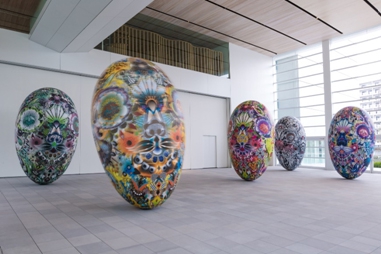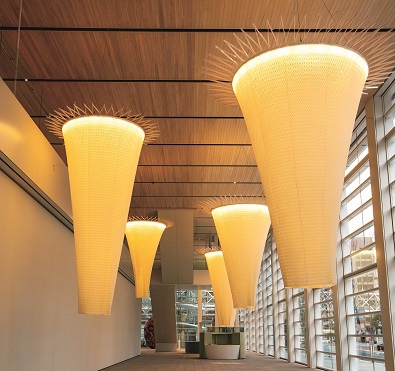Commissioned Installation
Eurasian Garden
 |
 |
| Marcel Wanders Eurasian Garden Spirits 2015 | Sudo Reiko Eurasian Garden, Watershed Weeds 2015 |
The Eurasian Garden – also known as the emergence of “love”
“An encounter between the top designers of the Netherlands and Japan,” appearing as a revived myth.
The large atrium that is the showpiece of Shigeru Ban’s Oita Prefectural Art Museum (OPAM) building. In that atrium exists a “Eurasian Garden.”
It has been four hundred years since the Dutch merchant ship “De Liefde” (“liefde” is Dutch for “love”) arrived at a small island, Kuroshima, off the coast of Usuki. Among the crewmembers rescued by the people of Usuki were Jan Joosten, who later became an advisor to the shogunate, and Miura Anjin (William Adams).
In his piece, which takes the form of a large rubber balloon, the noble of the Dutch designer, Marcel Wanders, presents Oita with his “flowers of death,” a recurring symbol of a European art tradition that has existed since the middle ages, “still life and skeletons,” or, in other words, “life and death.” The reason for this is because the “Eurasian” tradition of “the circulatory ideology of life and death” that has existed since the Celts has also been present in Japan, as argued by Lafcadio Hearn, who stated that: “In Japan the dead return during the obon festival and the equinoctial week,” and that “Japan is a country of the dead.”
Confronting Wanders is Sudo Reiko, who leads the world of contemporary design due to her unique achievements in textiles. Inspired by traditional Oita craft work and bamboo weaving techniques, the surface of the second floor of the atrium resembles the surface of water, containing an “underwater lotus,” the flower of Asia, or perhaps a large chandelier made of floating water grass.
Japan has a deep-rooted cultural connection to “water” due to its traditions and subtropical Asian climate. In OPAM’s atrium, underneath the faintly shining chandelier that recalls the phrase “praising shadows,” we, in being linked to our “aquatic animal” biological ancestors, become part of the cycle of transmigration. This is not a modern 21st century “Netherlands vs. Japan Showdown,” for as the great philosopher and thinker from Aki in Kunisaki, Miura Baien said, “the world exists in a state of polarity, and consists of encounters between different fragments that form part of the same whole.” These like-minded people, who have previously been separate and had not encountered one another, exist as different parts of the same body, and when they discover one another, they cooperate with one another, and a design that is “love” emerges.
(Notes)
The concept of the “flowers of death” piece, as well as information on the deeply-rooted Dutch tradition of “still life,” were communicated to us by Mr. Marcel Wanders. The information on Hearn and was relayed to us second-hand by the architect Mr. Kojima Gakutoshi. The Celtic cycle of transmigration was explained to us by Ms. Tsuruoka Mayumi. The information on Baien was gathered from a researcher at the Miura Baien Museum, Mr. Hamada Akira, as well as from documents within the museum. The original reinterpretation of his ideas was based auther’s own understanding of his thoughts and philosophy.


